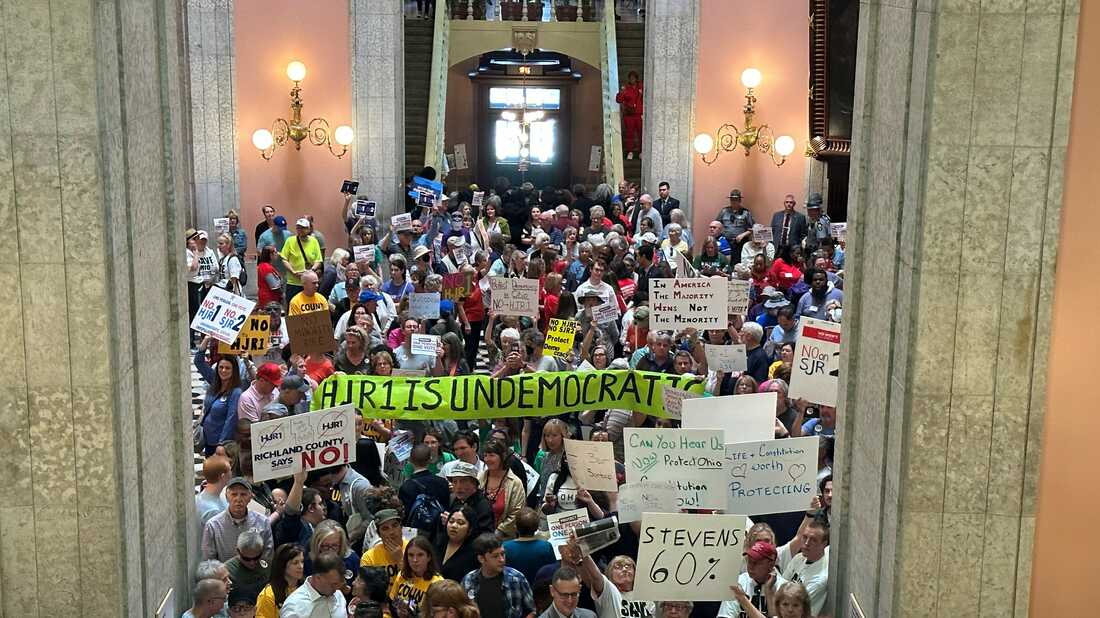 Samantha Hendrickson/AP
Samantha Hendrickson/AP
CINCINNATI, Ohio — On Tuesday, voters will go to the polls for a special election about Issue 1. This is a ballot measure that wants to make it harder for voters to change Ohio’s constitution.
If the measure passes, future constitutional changes would need 60% of the vote instead of the current simple majority, which has been Ohio’s standard since 1912.
Frank LaRose, Ohio’s Republican Secretary of State, came up with the idea. He said it was to keep wealthy, out-of-state special interests from getting into Ohio’s founding document.
LaRose said, “We’ll probably talk about changing the Constitution for the rest of our lives.” “That is a very important point.”
People who are against the referendum think that the timing is meant to stop a constitutional amendment that will be on the ballot in November and would put reproductive rights into the state constitution.
What Issue 1 has to do with the right to have an abortion in Ohio
All of this started last summer when Ohio’s ban on abortions after six weeks went into effect. Soon after, people all over the world heard about a 10-year-old girl who had been raped and had gone to Indiana for an abortion because doctors in Ohio wouldn’t treat her.
The ban was put on hold because of a lawsuit, but groups got together to write an amendment to Ohio’s constitution that would guarantee access to abortions and started collecting signatures for a November ballot issue.
Republican lawmakers with a supermajority couldn’t get their idea for 60% voter approval on the state’s May primary ballot, so they came up with a new plan in February: an August special election.
There was just one problem: in December, Republicans passed a law that said most special elections in August would no longer be held. LaRose said it shouldn’t be a problem when she testified in favor of that law.
“I don’t think holding elections in August is a normal way to do things,” he said.
“But it’s not unusual for the state legislature to decide to hold an election in August,” LaRose said.
It is rare, though, because the last time a special election for the whole state was held in August was in 1926.
 Karen Kasler/Statehouse News Bureau/Ohio Public Radio
Karen Kasler/Statehouse News Bureau/Ohio Public Radio
People who disagree show up at the Ohio Statehouse
A large group came together to fight against raising the approval threshold to 60%, and hundreds of them showed up at the Statehouse in May.
Even though there were protests, Republican lawmakers went ahead and even added a rule that would make it much harder for groups to put amendments on the ballot.
Now, they’d have to get signatures from all 88 counties instead of just 44, which the law says now. In a state as big and rural as Ohio, that would make it almost impossible for grassroots groups to get amendments on the ballot.
Even with the rules in place, it’s not easy for citizens or special interest groups to get amendments on the ballot. Since 1912, 172 changes have been made to Ohio’s constitution, but only 19 came from people or groups.
The plan was easily passed by Republican lawmakers with a supermajority. After the vote, Democrats and protesters in the Ohio House chamber started chanting, “One person, one vote!”
Opponents of the measure filed a lawsuit, saying that the resolution broke a law that says most special elections can’t be held in August. The Ohio Supreme Court ruled along party lines that the law doesn’t apply to state legislators who want to put a constitutional amendment on the ballot.
National attention is drawn to a controversial referendum.
The coalition for Issue 1 is mainly made up of anti-abortion groups, gun rights groups, and the state’s biggest business groups who are worried about an upcoming change to the minimum wage.
Unions, groups for abortion rights and gun law reform, Ohio’s four living ex-governors, and five ex-attorneys general from both parties are all against the bill.
Mike Curtin, a Democrat who used to be a state representative, has been one of the most vocal opponents of Issue 1.
“It was a rush job on a critical question. Ohioans have had the right to change their state constitution for 111 years, but now they need 60% of the vote to do so,” Curtin said.
Even though it is the middle of August, when most people are on vacation, Ohioans have turned out to vote early. Some counties have reported long lines, and around $22 million has been spent on ads on both sides of the issue, almost all of which came from outside Ohio.
Tuesday, there is only one issue on the ballot.
 Samantha Hendrickson/AP
Samantha Hendrickson/AP Karen Kasler/Statehouse News Bureau/Ohio Public Radio
Karen Kasler/Statehouse News Bureau/Ohio Public Radio